Rangers midseason report: Team MVP, most improved, main concern, second-half keys and more
The New York Rangers have officially passed the halfway point of the 2023-24 season, which got off to such a promising start but has been dosed with a splash of cold water in the past month.
They remain in strong position overall at 27-13-2 while perched atop the Metro Division, but their first-place cushion has been cut down to three points by the streaking Carolina Hurricanes. They've also gone from the NHL's best points percentage in early December to tied for fifth following a 9-9-1 stretch in their last 19 games.
The initial boost from new head coach Peter Laviolette has faded, but his direct communication and attention to detail have been largely viewed as positives within the locker room. From a preparation, systematic and leadership standpoint, the Blueshirts believe they're better off.
Most importantly, the march to a third straight playoff appearance is on.
"There's peaks and valleys inside of a season," Laviolette said following Sunday's 2-1 win over the Washington Capitals, which snapped a season-long four-game losing streak. "You've got to just maintain a course and try to fix things, try to make things right. Everybody's got to deal with things at some point, but I thought our guys stayed focus."
The Rangers have 40 regular-season games remaining to correct their problem areas and gear up for chasing their ultimate goal: Ending the franchise's 30-year Stanley Cup drought.
Let's look ahead to the keys in the second half of the season, as well as hand out awards and assess everything that's happened in the first 42 games in our annual midseason report:
Midway MVP: Artemi Panarin
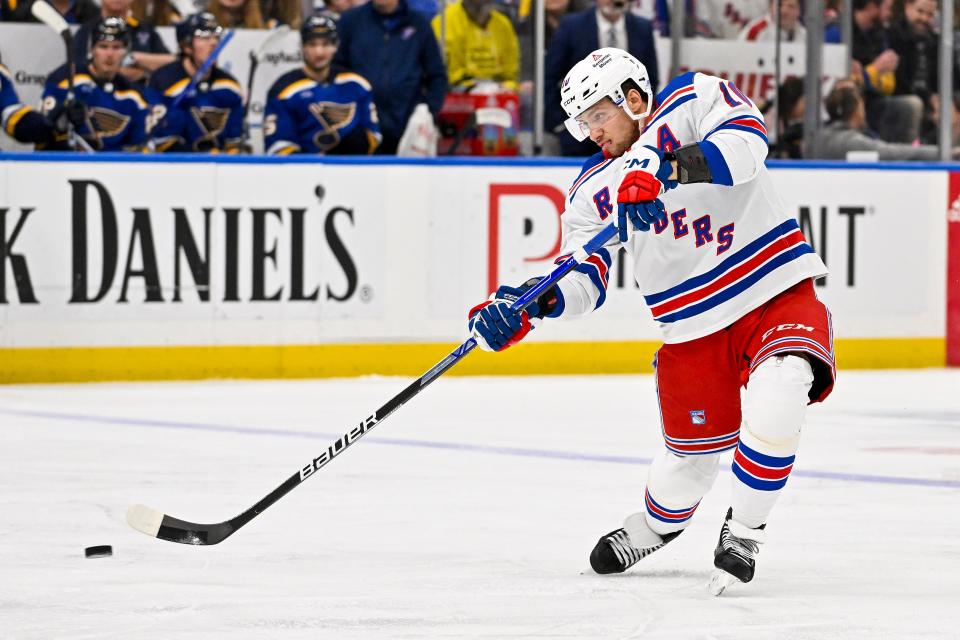
There isn’t much debate to be had on this one. No. 10 has been far and away the Rangers’ best and most dependable player through the first half of the season and deserves to be mentioned in the Hart Trophy conversation.
You can start with the lofty stats, with his 59 points leading the team by a wide margin (next up is Vincent Trocheck with 42) and sitting tied for third in the league. He’s on pace for what would easily be a career-high 115 points, but it’s his goal-scoring prowess that’s been especially noteworthy. Panarin, long known as one of the NHL’s top passers, has netted 27 goals at the midway point.
He’s on pace for 53, which would shatter his previous career high of 32. And he’s doing it by continuing to evolve his game at the age of 32.
This offseason, Panarin decided he needed to incorporate more movement away from the puck to work his way into better shooting positions. That aggressive mindset, coupled with newfound chemistry between him, Trocheck and Alexis Lafrenière, has Panarin playing the best hockey of his career. Who knows where the Rangers would be without that line, which has been their only steady source of five-on-five offense all season.
The underlying numbers bear out his impact, as well. Panarin leads all New York forwards who have appeared in more than 10 games with a 55.68% xGF, 57.15% Corsi and 56.36% shot share, according to Natural Stat Trick.
Above all, Panarin’s biggest contribution has been consistency. He’s registered at least one point in 35 of 42 games played, carrying the team through stretches of injury and ineffectiveness from other key players.
Most improved: Alexis Lafrenière
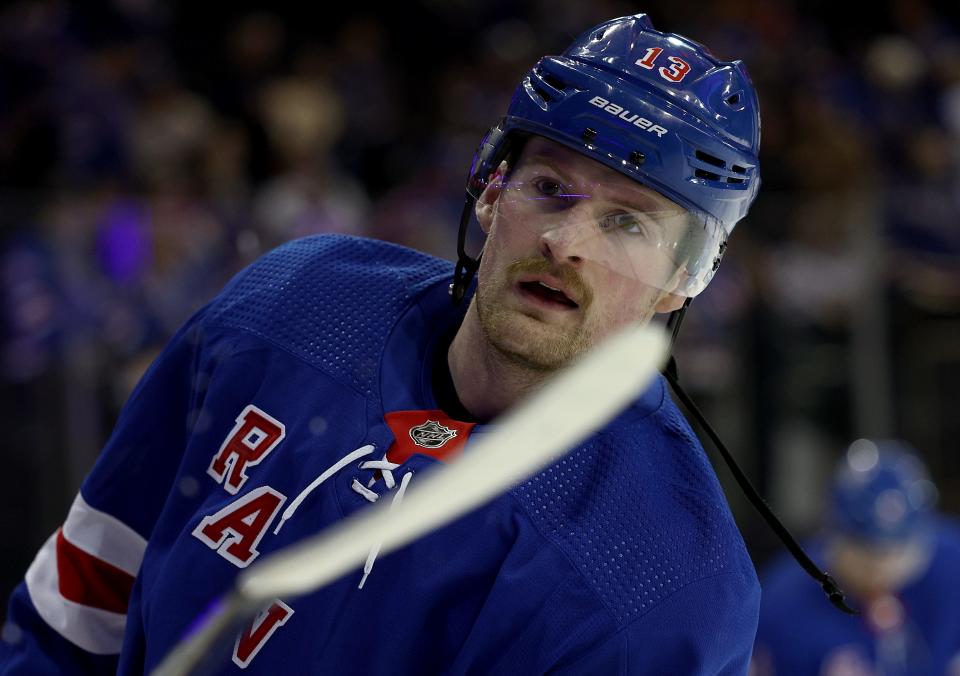
You could make a case for a couple veterans who have really stepped up in Trocheck and captain Jacob Trouba, but Lafrenière has taken the biggest steps to solidify his career trajectory.
The 22-year-old forward received his share of criticism the last few years as his production lagged behind other recent No. 1 overall draft picks. There were some obvious reasons for that, with Lafrenière playing a secondary role with very limited power-play usage compared to his contemporaries. But it was clear that his lauded playmaking skills weren’t translating as quickly as most had hoped, with multiple scouts questioning his skating and ability to separate.
Those cries grew louder during an underwhelming preseason, but the critics have largely been silenced since the regular season began. Laviolette placed him in a prominent spot on the opposite wing from Panarin and let him be, and Lafrenière has rewarded that trust with his best season yet.
His 26 points (11 goals and 15 assists) don’t tell the whole story, although it does put him on pace to hit 20 goals and 50 points for the first time in his four-year career. His nine even-strength goals are tied with Chris Kreider for second most on the team, but the reality is he could have even more. Lafrenière has been credited with 54 individual high-danger scoring chances at 5v5, which leads all Rangers, while his 54.79% xGF and 57.15% Corsi rank second among forwards behind Panarin. His 112 shots on goal rank third, but he's only converted 9.8% into goals.
There’s been some bad luck involved, but the next step is finishing at a higher rate.
The encouraging part is that Lafrenière, who ended an eight-game goal drought Sunday, is getting himself into quality scoring positions and looking like a much more assertive, confident player. He’s been dynamic with the puck on his stick and showing a much-improved understanding of how to be an effective player at this level, all while making a fairly seamless transition to fill a massive organizational hole at right wing.
Biggest surprise: Goalies trending in opposite directions
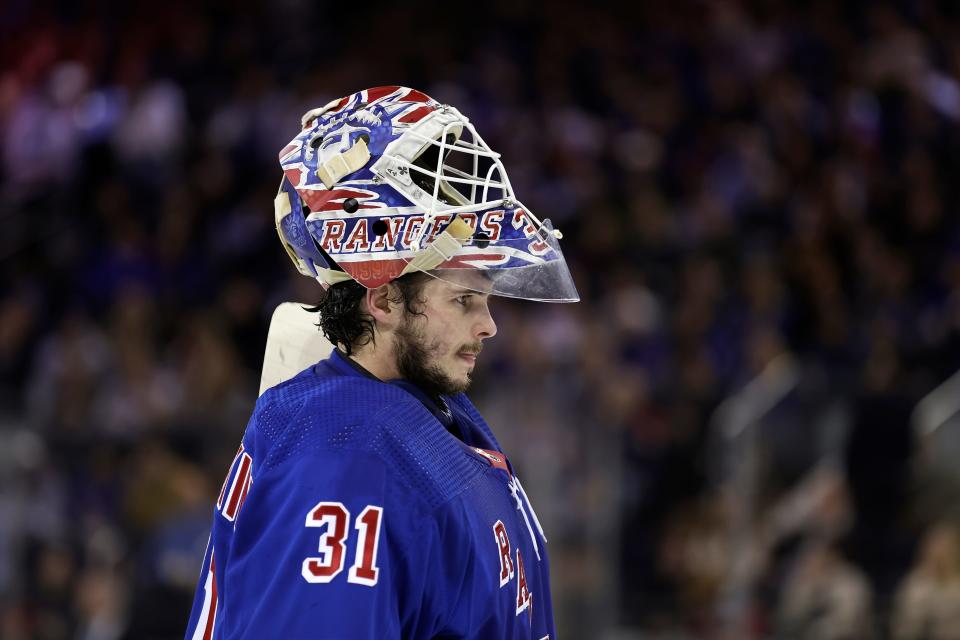
Who would have guessed that 37-year-old Jonathan Quick would be outplaying an in-his-prime Igor Shesterkin?
Quick came to New York over the summer with his career on life support, but he’s revived it with a first half that few saw coming.
He finished with a sub-.900 save percentage in three of his final five years with the L.A. Kings, which bottomed out at .876 last season and led to him being traded twice. The Rangers took a flyer on the Connecticut native as an $825,000 backup, but expectations were low about how much they could get out him.
He hasn’t only exceeded them – he’s shockingly been the Blueshirts' most reliable netminder.
The three-time Stanley Cup champion has Shesterkin beat in SV% (.912 vs. .903), goals against average (2.49 vs. 2.83) and shutouts (two vs. zero). That’s not to say there’s any goalie controversy, but Quick has earned himself more ice time while providing a stabilizing presence in his 15 appearances. He’s benefitted from the "simple" approach of longtime Rangers goalie coach Benoit Allaire and made some spectacular saves along the way, most memorably his reverse scorpion in Florida on Dec. 29.
QUICKIE IN HIS SCORPION ERA. pic.twitter.com/3Nc4ToHskp
— New York Rangers (@NYRangers) December 30, 2023
We’ll see if the soon-to-be 38-year-old (his birthday is Sunday) can continue his resurgence in the second half, but Quick's steady play has been critical at a time when the Rangers’ No. 1 goalie hasn’t performed up to his usual standards.
Some of the blame for Shesterkin's inconsistency certainly falls on the defense in front of him, which has repeatedly put the 28-year-old in vulnerable situations. (More on that shortly.) But the momentum-altering saves we're used to seeing the 2022 Vezina Trophy winner make have largely been evading him this season, with his Goals Saved Above Average in the negatives (-3.42) for the first time in his career.
Least valuable player(s): Out-of-place veterans
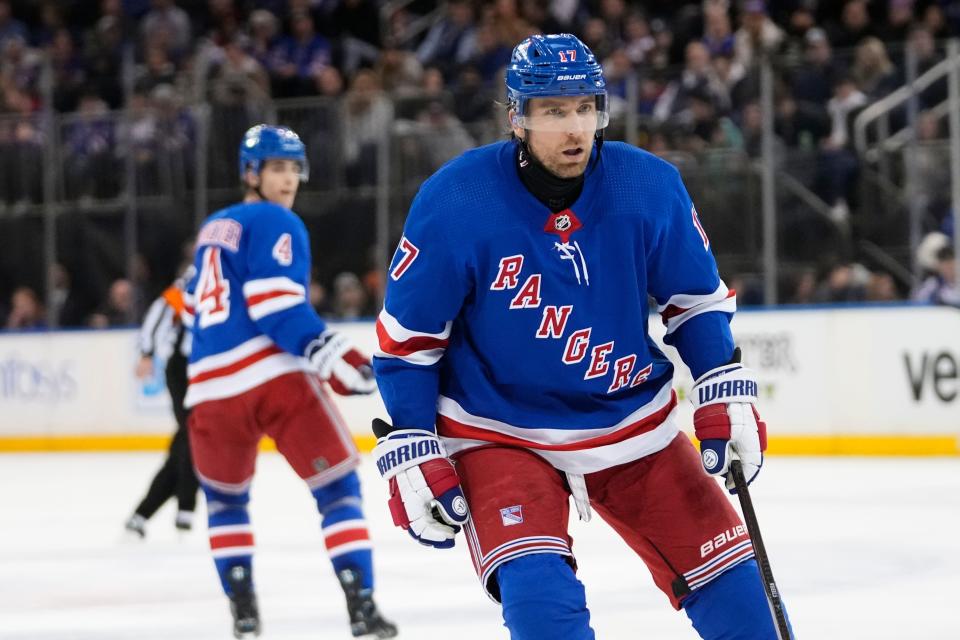
I don’t feel anyone is truly deserving of this unwanted distinction – the Rangers received valuable contributions from all over during their hot start – so we’re going to split it between two veterans who have been asked to bite off more than they can chew at this stage in their careers.
Through no fault of their own, both Nick Bonino and Blake Wheeler have been forced to play more substantial roles than originally anticipated. Injuries to Filip Chytil and Kaapo Kakko created voids at first-line right wing and third-line center, and filling those holes has been problematic.
Wheeler, who has looked a step behind while registering 15 points (five goals and 10 assists) through 42 games, was finally dropped down last week after producing a 45.69% xGF in over 220 minutes on the top line with Kreider and Mika Zibanejad. There was a stretch in December when the 37-year-old heated up with eight points in seven games, but he's yet to register a point in seven games since the calendar flipped to 2024.
Meanwhile, Bonino remains in Chytil’s vacant spot due to New York’s lack of center depth, but he’s stuck on just five points (one goal and four assists) through 41 games. He’s a dependable penalty killer, solid faceoff man and fearless shot blocker, but the third line has been a non-factor offensively since he joined.
The metrics don’t paint a pretty picture, either, with the proud vets ranking last (Bonino at 38.18%) and second-to-last (Wheeler at 42.85%) on the team in xGF.
They both inked one-year, $800,000 deals last summer as low-risk depth signings, saving valuable cap space in the process. That’s why it’s hard to be overly critical – and they can still be useful if deployed in the right situations – but neither is the answer at 1RW or 3C.
Team strength: Special teams
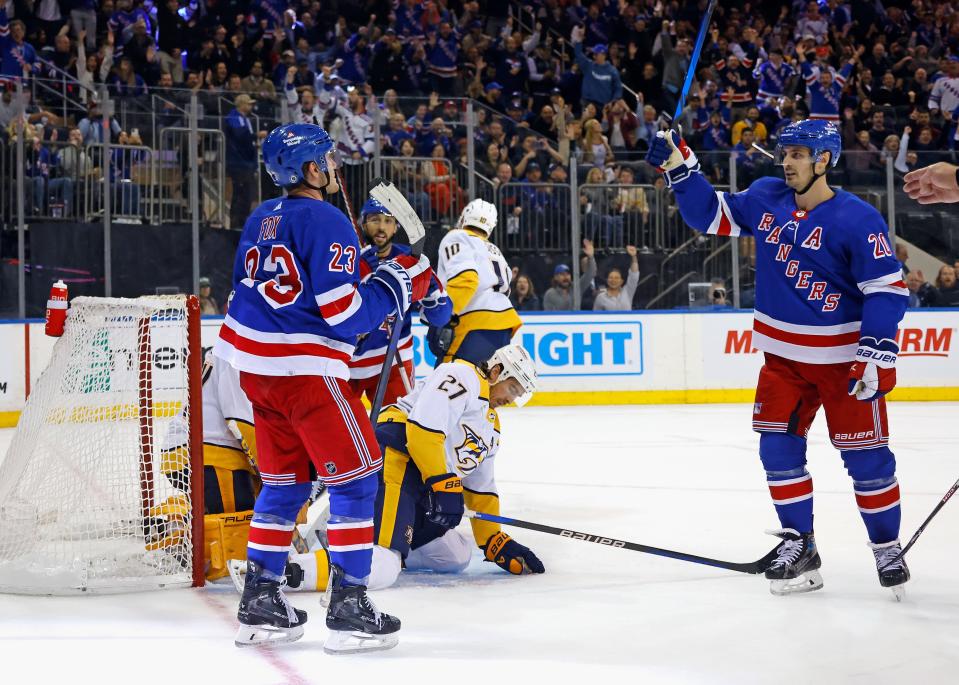
The most reliable part of the Rangers' collective game has been their top power-play unit featuring Kreider, Panarin, Trocheck, Zibanejad and Adam Fox. They're the reason New York is ranked second in the NHL with a 28.2% conversion rate.
While the five-on-five offense has run hot and cold, the power play has been humming from Game 1 on. They've been slump proof thanks to a collection of high-skill players who complement each other well and an improved approach that's predicated on interchangeable parts.
The PP grew stale at times last season when opposing teams knew the Rangers were trying to work toward a Zibanejad one-timer in the left circle, but under Laviolette and assistant coach Michael Peca, we're seeing more creativity, with each player given the freedom to roam and switch positions on the fly. Kreider is still doing his thing at the net front while leading the team with nine PP goals, but Panarin (eight), Trocheck (seven) and Zibanejad (six) aren't far behind.
Four of the five members (Fox, Kreider, Panarin and Zibanejad) have been together for five seasons now, with that continuity evident in the way they read off each other. The result is the most dangerous power play the Rangers have had in recent memory, with at least one PP goal in 30 of their 42 games.
The penalty kill has been rock solid, as well. They're not quite as efficient as the PP, but rank seventh in the league with an 83.9% success rate. They've kept opposing teams off the board in 27 of their 42 games, adding to the level of comfort the Blueshirts have in all special teams' situations.
Primary concern: Defending against the rush
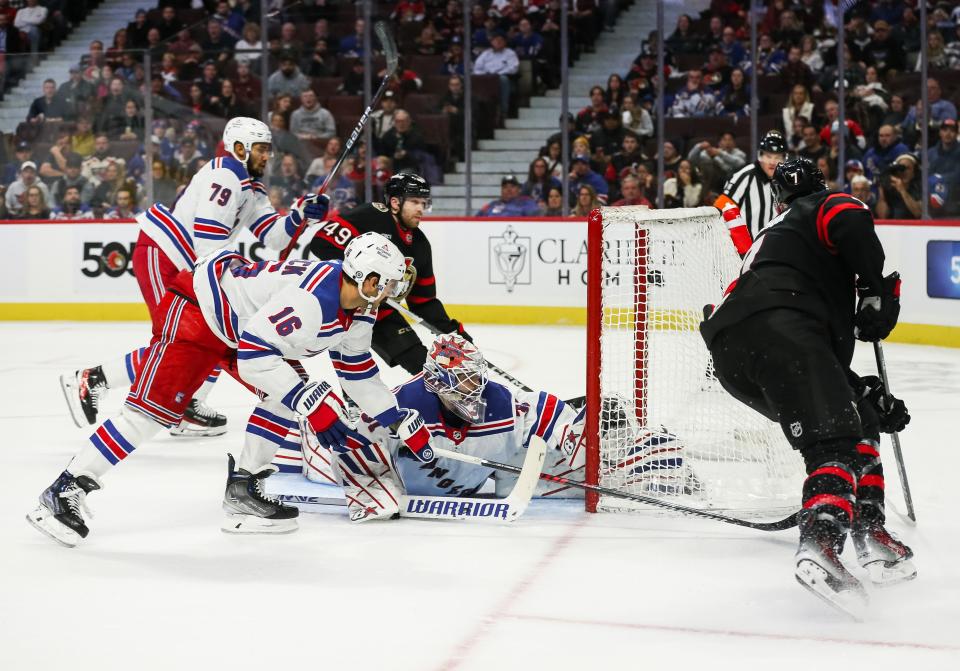
This was not the case in the early portion of the season, when the Rangers seemed fully bought into Laviolette's hard-working, defense-first approach while stifling opponents with an effective 1-3-1 neutral-zone trap. But there's been a notable drop-off in the last month or so.
They ranked first in the NHL with 2.22 goals allowed per game in 18 games through Black Friday but have seen that average ballon to 3.29 in the 24 games since, which sits 23rd in that span. There are a variety of factors that have led to the defensive slippage, but the clear weakness has been defending against the rush, where the Rangers grade out as the worst team in the league, according to Clear Sight Analytics' xGA model.
Their defensive-zone coverage hasn't been a big issue, but they've continuously allowed high-danger scoring chances in transition situations.
Turnovers have been an Achilles' heel, whether it's fumbling D-zone breakouts, taking unnecessary risks in the neutral zone or coughing the puck up near the offensive blue line. Many of those giveaways are fueled by the poor decision-making that Laviolette has lamented, with opponents often turning those mistakes into quick-strike opportunities. That's happening several times per game lately and leading to some lopsided results, with the Rangers already allowing five goals or more in a game 10 times halfway through this season after doing it six times in all of 2022-23.
The odd-man rush problem is nothing new for this group. Previous coach Gerard Gallant grew increasingly frustrated with the penchant for high-risk passes and east-west hockey that left them vulnerable defensively, and now Laviolette is facing the same dilemma.
We saw them buckle down and play a straight-ahead, patient style for about a quarter of the season, so we know they're capable. But they say that old habits die hard, and that's been evident throughout this extended rough patch.
The reality is that Rangers must clean it up if they have any intention of going on a deep playoff run, otherwise they could be looking at another early exit − especially if they match up with the type of skilled, speedy team that can exploit them.
3 keys to the second half
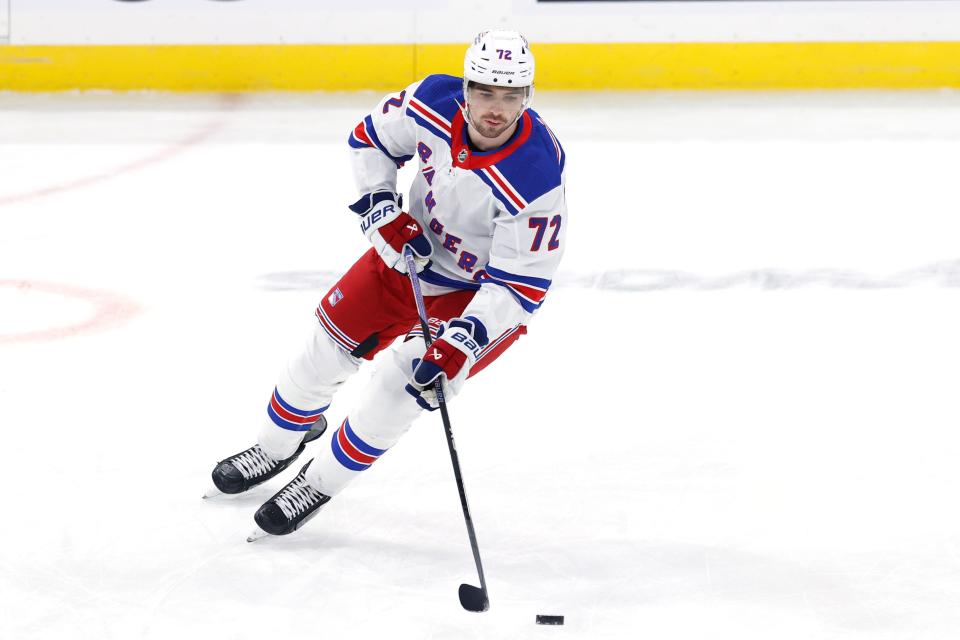
1) Tighten up 5v5 play − Given the Rangers' strength on special teams, they don't need to be great at five-on-five. But they need to be better than this.
Improving their rush defense and puck management are the top priorities, but the to-do list extends to upping their effort on the forecheck and getting back to frustrating opponents with a clogged-up neutral zone. They also need to find consistent 5v5 scoring options outside of the Panarin-Trocheck-Lafrenière line, which has shouldered the offensive burden all season.
The Blueshirts are being outscored at five-on-five, 89-85, with a 49.95% xGF that ranks 17th in the league. That doesn't exactly scream "Stanley Cup contender."
2) Improve forward depth − This starts with getting healthy, and the good news is that Kakko returned Sunday. He represents the Rangers' best internal 1RW option, which is why, even after missing 21 games with a left-leg injury, Laviolette inserted him right back in that spot. Veteran Tyler Pitlick is also getting closer to returning from his lower-body injury, which would provide a depth piece for an ailing bottom six.
The situation is much murkier with Chytil, who remains in Czechia recovering from his latest concussion. The 24-year-old center has missed 32 games and counting, with the lingering symptoms raising concerns about his long-term health and the risks of playing. He's motivated to come back, according to one person close to the situation, but there's no telling when he'll be ready and what the odds are of reoccurrence.
The Rangers have to prepare for the possibility of losing him for the season. And even if he does reestablish his place in the lineup, they still look like they're a piece or two away up front. The current state of the bottom six does not appear championship caliber.
Trading for an insurance policy at center is looking like priority No. 1, and you could make an argument that they also need one more RW. But how much they'll have to spend will depend on Chytil's status. If he remains on long-term injured reserve, it would add over $4.4 million in available salary cap space at the March 8 deadline. But if he's going to be activated before the end of the regular season, they're looking at a very limited number, likely in the $1 million-to-$1.5 million range.
Team president Chris Drury is forming a two-pronged plan, and he's expected to be aggressive in his pursuit of whichever targets he determines the Rangers can afford.
3) Get more out of stars not named Panarin − We’ve covered a frustrating first half for Shesterkin, with getting him back to top form a must. Despite the star power in front of him, the Russian netminder remains the team’s most important player given his critical position and ability to steal wins when he’s locked in. He can be the X-factor in any seven-game series.
But Shesterkin's not the only big name the Blueshirts are depending on. Consider this: Panarin’s 29 points at 5v5 match the combined total of Kreider and Zibanejad. The overall numbers for both players are respectable, but their line’s lack of consistency has created an overreliance on Panarin, Trocheck and Lafrenière to carry the team at even strength.
And then there’s Fox, who didn’t quite look like himself for over a month after returning from a lower-body injury that cost him 10 games in November. The former Norris Trophy winner went 19 straight without a goal and generally seemed to have fewer dangerous touches than we're used to seeing, but that’s turned around significantly the last few games. The 25-year-old has scored four times in the last four contests, and of equal importance, he’s noticeably dancing around the offensive zone and making dynamic plays.
The Rangers will need more of that version of Fox in the second half, along with an uptick from Shesterkin, Kreider and Zibanejad in support of Panarin. They’ll only go as far as their top players take them.
Vincent Z. Mercogliano is the New York Rangers beat reporter for the USA TODAY Network. Read more of his work at lohud.com/sports/rangers/ and follow him on Twitter @vzmercogliano.
This article originally appeared on Rockland/Westchester Journal News: Rangers midseason report: Handing out awards at NHL's halfway point

